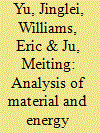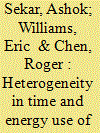|
|
|
Sort Order |
|
|
|
Items / Page
|
|
|
|
|
|
|
| Srl | Item |
| 1 |
ID:
097254


|
|
|
|
|
| Publication |
2010.
|
| Summary/Abstract |
Owing to booming mobile phone ownership and a short product innovation cycle, waste mobile phones are flooding China. In 2008, about 560 million mobile phones were produced and 634 million users subscribed to a mobile phone plan in China. These large numbers mean that the charging and disposal of mobile phones has the potential to have significant impacts on the environment. Thus the evaluation of material and energy consumption of mobile phones is an important task in the end-of-life management of electronic products. This paper uses material flow analysis (MFA) and life cycle assessment (LCA) methods to estimate the life cycle impacts of mobile phones in China from manufacturing energy, use phase and generation of waste mobile phones. Results indicate over the mobile phone life cycle, manufacturing accounts for 50% of the total energy consumption, whereas the use phase accounts for only 20%. Mobile phones and supporting infrastructures account for a rapidly increasing 0.17% of Chinese energy use. In 2008, around 77 million units of waste mobile phones were generated in China. To manage this energy use and recover valuable materials recommendations are made to increase lifespan, improve energy efficiency during use and ensure recycling.
|
|
|
|
|
|
|
|
|
|
|
|
|
|
|
|
| 2 |
ID:
042654


|
|
|
|
|
| Publication |
London, Andre Deutch Ltd., 1970.
|
| Description |
576p.hbk
|
| Standard Number |
0233961631
|
|
|
|
|
|
|
|
|
|
|
|
Copies: C:1/I:0,R:0,Q:0
Circulation
| Accession# | Call# | Current Location | Status | Policy | Location |
| 005807 | 972.901/WIL 005807 | Main | On Shelf | General | |
|
|
|
|
| 3 |
ID:
150900


|
|
|
|
|
| Summary/Abstract |
There is substantial variability in residential energy use, partly driven by heterogeneous behavioral patterns. Time-use is relevant to energy when consumption tracks the time a device is used. Cluster analysis is a promising approach to identify time-use patterns. If clusters with particularly long time use and thus high energy consumption emerge, these groups could merit targeted policy intervention. We investigate these ideas via an empirical study of time use for television watching in the U.S. Three clusters were identified. In 2013, the average time spent watching television by Clusters 1, 2 and 3 are dramatically different: 1.1, 3.5 and 7.7 h per day respectively. While members of Cluster 3 are only 14% of the total population they represent 34% of TV energy consumption. The population of Cluster 3 tends to be older, less employed and less educated. Energy savings per adopter is much larger for Cluster 3, suggesting much higher benefits from efficient devices. These results are relevant to the design of efficiency programs, indicating potential for variable rebates and/or tiered communication. With variable rebates, utilities would offer higher incentives to high-use customers. In tiered communication, utilities would devote more resources to engage customers with larger savings potential.
|
|
|
|
|
|
|
|
|
|
|
|
|
|
|
|
| 4 |
ID:
098267


|
|
|
|
|
| Publication |
2010.
|
| Summary/Abstract |
In society's quest to mitigate climate change it is important to consider potential trade-offs in climate solutions impacting other environmental issues. This analysis explores the life cycle water consumption of alternative low-carbon energy sources for transportation. Energy sources analyzed include both biofuels used in internal combustion engines and low-carbon electricity generation methods used in conjunction with electric vehicles. Biofuels considered are corn-based ethanol, soybean biodiesel, cellulosic ethanol from switchgrass, and microbial biodiesel. Electricity sources analyzed are coal with carbon sequestration, photovoltaic cells, and solar concentrators. The assessment method used is hybrid life cycle assessment (LCA), which combines materials-based process method and the economic input-output (EIO) method. To compare these technologies on an even footing the life cycle water use to propel a passenger vehicle one mile is estimated. All technologies evaluated showed an increase in water consumption compared to unleaded gasoline when water use from vehicle manufacturing was included. Scale-up calculations showed that mass adoption of electric vehicles and some configurations of algae and switchgrass systems could potentially contribute to the decarbonization of transportation with tolerable increases in overall water consumption. Irrigated crop based biofuels however were found to have significant potential impact on water resources when scaled up to macroscopic production levels.
|
|
|
|
|
|
|
|
|
|
|
|
|
|
|
|
| 5 |
ID:
098578


|
|
|
|
|
| Publication |
2010.
|
| Summary/Abstract |
In society's quest to mitigate climate change it is important to consider potential trade-offs in climate solutions impacting other environmental issues. This analysis explores the life cycle water consumption of alternative low-carbon energy sources for transportation. Energy sources analyzed include both biofuels used in internal combustion engines and low-carbon electricity generation methods used in conjunction with electric vehicles. Biofuels considered are corn-based ethanol, soybean biodiesel, cellulosic ethanol from switchgrass, and microbial biodiesel. Electricity sources analyzed are coal with carbon sequestration, photovoltaic cells, and solar concentrators. The assessment method used is hybrid life cycle assessment (LCA), which combines materials-based process method and the economic input-output (EIO) method. To compare these technologies on an even footing the life cycle water use to propel a passenger vehicle one mile is estimated. All technologies evaluated showed an increase in water consumption compared to unleaded gasoline when water use from vehicle manufacturing was included. Scale-up calculations showed that mass adoption of electric vehicles and some configurations of algae and switchgrass systems could potentially contribute to the decarbonization of transportation with tolerable increases in overall water consumption. Irrigated crop based biofuels however were found to have significant potential impact on water resources when scaled up to macroscopic production levels.
|
|
|
|
|
|
|
|
|
|
|
|
|
|
|
|
|
|
|
|
|